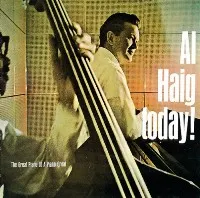
Styles: Jazz Post Bop
Year: 2017
File: MP3@320K/s
Time: 65:11
Size: 150,6 MB
Art: Front
(3:51) 1. City Limits
(2:27) 2. Grand Prix
(3:11) 3. Time Square
(3:33) 4. Too Good to Be True
(3:33) 5. Nights of Jazz
(3:14) 6. Maio's Beach
(3:23) 7. The Things I Love
(2:59) 8. Little Giant
(3:28) 9. The Yacht Club
(2:41) 10. Congo Square
(3:10) 11. Springtime for Lovers
(2:14) 12. Shop 'Till You Drop
(3:29) 13. Free Wheeling
(3:23) 14. Cocktail Jazz
(3:07) 15. Set 'Em up Jim
(4:08) 16. The Street of Jazz
(3:19) 17. Manogs and Bananas
(3:17) 18. The Blue Note
(3:00) 19. At the Three Deuces
(3:34) 20. Cafe Chic
André Charlier born in VERVIERS (Belgium) in 1962. He started the drums in 1978. He studied at the conservatory of Liège in Jazz class and took classes with Vinnie Johnson and Bruno Castellucci. He studied at the Musician Institute in Los Angeles in 1985-1986. In 1988-1989, he began a series of tours with the singer Maurane. Winner of the Defense Competition in 1989, he was awarded the prize for best soloist at the international francophone jazz competition in 1991. With his alter-ego Benoît Sourisse, they create the Charlier-Sourisse tandem. (6 albums and close collaborations with Jerry Bergonzi, Kenny Garrett, Alex Kurt Rosenwinkel, Alex Sipiagin, Nick Smart ... Didier Lockwood's stage companion since 1993, with whom he recorded several albums, including the last "Apesantar" in 2016. Record many albums for various artists, movies music etc ...He also performs with numerous bands and artists such as Captain Mercier, Jean-Jacques Milteau, Michel Petrucianni, John Scofield, Scott Henderson, Toots Thielemans, Philip Catherine, Jean-Marie Ecay, Stephane Guillaume, Mighty Mo Rodgers, Dave Liebman, Laurence Allison ... Passionate about pedagogy he is co-founder and co-director of the CMDL, professor of rhythm and drums and involved in many courses and conservatories. With Benoît Sourisse, he creates a new jazz method called "Les Cahiers Charlier / Sourisse" (supported notably by François-René Duchâble, Jerry Bergonzi ...) by Leduc. The tandem "Charlier Sourisse" has just released its sixth album recently, a double album in big training called " multiquarium Big band." Translate by Google http://www.charliersourisse.com/biographies
Born in Grenoble in 1964, Benoît Sourisse, pianist / organist, joined Paris in 1986. With his alter / ego André Charlier they create the tandem Charlier / Sourisse (7 albums and close collaborations with Jerry Bergonzi, Kenny Garrett, Kurt Rosenwinkel, Alex Sipiagin ...) Fellow and music director of the violinist Didier Lockwood between 1994 and 2004, he also shares the stage or the studio with many prestigious musicians such as Toots Thielemans, John Scofield, Philip Catherine, John McLaughlin, Mike Stern, Steve Gadd, Quincy Jones , Phil Collins, Gil Goldstein, Michel Petrucciani, Perico Sambeat ... Passionate about Blues and Rhythm'nBlues, he is the musical director of two albums by Jean-Jacques Milteau, as well as that of the American singer Demi Evans. He is also the co-founder of "Captain 'Mercier", an emblematic group of French Rythm'n Blues, who has given over 1300 concerts in 23 years, recorded 4 CDs, a DVD and won the Audience Award at the 2003 Victoires du Jazz. In 2009 Benoît, André and Chantal Charlier founded the jazz label "Gemini Records" which won two awards in 2010 for the last album of Stéphane Guillaume (Windmills Chronicles) After teaching improvisation for nearly 15 years at the National Conservatory of Music in Lyon, he is today co-head of the "CMDL" co-founded in 1999, of which he is a professor of piano and music. 'hear. Very attached to the transmission, he gives many Masterclasses in France and abroad (Hanoi, Nouméa, Liège, Lausanne, Lisbon, Sao Paulo ..). Translate by Google http://www.charliersourisse.com/biographies




















